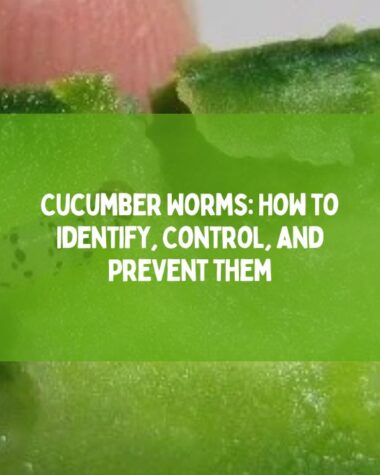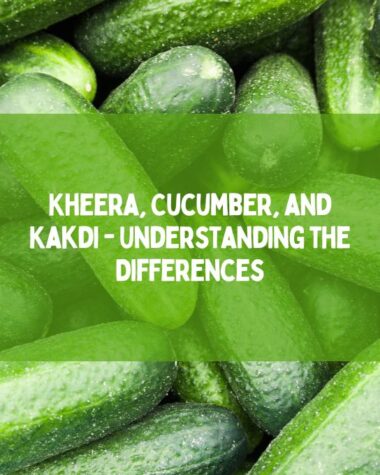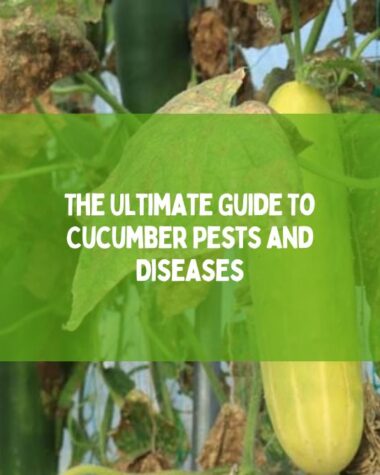Cucumber leaves can turn yellow due to a variety of reasons such as nutrient deficiencies, pest infestations, overwatering, or disease. To diagnose the issue, examine the leaves closely and address any underlying problems. Proper watering, fertilization, and pest control measures can help prevent the yellowing of cucumber leaves.
Have you ever wondered why your cucumber leaves are turning yellow? It’s a common problem for many gardeners, but it doesn’t have to be.
It can be disheartening to put so much effort into growing your own produce only to find out that something is wrong with it. Cucumbers are no exception – when their leaves start to turn yellow, it may seem like all hope is lost. But don’t give up yet! With a bit of knowledge and preventive care, you can keep those plants healthy and strong.
In this article, we’ll explore the reasons behind this issue and discuss some tips on how to prevent it from happening in the future.
So let’s dive right in and take a closer look at what might be causing this discoloration in the first place!
What Are the Causes Of Cucumber Leaves Turning Yellow?

Yellow leaves on cucumber plants can be caused by a variety of factors. It’s important to identify the cause in order to provide the proper care for your plant. The most common causes of yellowing cucumber leaves are nutrient deficiencies, overwatering, and too much direct sunlight exposure.
Nutrient deficiencies often result in pale yellow or white spots between veins on leaves, with the rest of the leaf remaining green. This is usually caused by inadequate levels of nitrogen or potassium in the soil. To correct this issue you’ll need to fertilize your plant regularly with an all-purpose fertilizer that contains both nitrogen and potassium.
Here are some common reasons for cucumber yellow leaves.
Nutrient Deficiencies
Yellowing leaves on cucumber plants is usually a sign of nutrient deficiency. This can be caused by a lack of nitrogen, potassium, or phosphorus in the soil. If there are yellow spots on the cucumber leaves, it could be an indication of iron or zinc deficiency.
How to correct nutrient deficiencies in soil?
To correct these deficiencies and restore health to your cucumber plant’s leaves, you should apply fertilizer with the appropriate nutrients present. It is also important to test your soil regularly so that you know what kind of fertilizers would best suit your particular environment.
Related Reading:
- Why are Cucumber Leaves Wilting and Dying? Reasons and Solutions
- How To Grow Cucumber Organically? The Ultimate Guide
Environmental Factors
Environmental factors can cause cucumber leaves to turn yellow. Cucumbers are sensitive to temperature and water, so if the environment is too hot or too cold, it could be causing your plant’s leaves to yellow.
Soil Conditions
Soil conditions can play a role in why cucumber leaves are turning yellow and dying. If the soil is too wet or waterlogged, cucumbers can suffer from root rot, which will ultimately lead to the leaves become yellow and dry.
The best way to prevent this is by ensuring that your cucumber plants have well-draining soil so they don’t become overwatered. Additionally, it’s important to check the moisture level of the soil regularly using a tool like a trowel. If it feels overly damp then chances are you need to reduce watering frequency.
On the other hand, having overly dry soil can be just as detrimental for cucumber plants. When there isn’t enough water available, cucumber leaves turn yellow and wilt because they’re unable to absorb enough nutrients from the surrounding environment.
To help combat this issue, make sure you’re providing your plant with consistent hydration either through natural rain or manual irrigation methods such as sprinklers or drip systems.
Fungal And Bacterial Diseases

Fungal and bacterial diseases can be a cause of yellowing leaves on cucumber plants. These plant diseases are commonly found in wet weather conditions when the environment becomes favorable for their growth.
Some common signs of these diseases include yellow spots on the leaves or yellowing foliage. Certain fungi and bacteria will even produce lesions on the leaves which could eventually lead to wilting if left untreated.
In order to identify whether your cucumber plants have been affected by fungal or bacterial diseases, it’s essential to inspect them thoroughly.
- If you notice any discoloration of the leaves, such as yellow spotting or streaking, this could indicate an underlying problem.
- In addition, there may also be signs of white powdery mildew growing around the stems and leaf surfaces which is another indication that something may not be suitable for your plant’s health.
- It’s also worth noting that certain types of fungus and bacteria thrive better in warm temperatures so if you’re growing cucumbers in containers, ensure they are well-ventilated to avoid creating a hospitable environment for these pests.
If you suspect a fungal or bacterial infection is behind the yellowing of your cucumber leaves, treatment should begin immediately as soon as possible before too much damage has occurred.
How to get rid of it?
Start by removing any infected material from the area including fallen debris and dead foliage before applying fungicidal treatments specifically designed for controlling these problems. Following these steps should help reduce the spread of disease and improve overall plant health long term.
Insect Damage
Aside from fungal and bacterial diseases, insect damage can also be a cause of cucumber leaves turning yellow. Insects such as aphids, thrips, whiteflies, beetles, and leafhoppers feed on the sap of cucumber plants which can lead to discoloration of the leaves.
Here are some signs that insects may be causing your cucumbers‘ yellowed leaves:
- Presence of small yellow spots on the surface of the leaf
- Leaves curling or wilting
- Discoloration in patches or around veins
- Tiny webs along with sooty mold between leaf folds
- Holes in leaves caused by chewing insects
How to Remove this Disease?
If you suspect insect activity is what’s behind your cucumber plant’s yellowing leaves, there are a few steps you can take for treatment.
- Start by removing any visible pests from the plant using a cotton swab dipped in rubbing alcohol.
- Then use an insecticidal soap spray to treat both sides of each affected leaf.
- Finally, apply a neem oil solution directly onto the foliage once every week until symptoms have subsided.
- If these measures don’t help alleviate the problem, it might be time to bring in professional pest control services.
Temperature Stress
Temperature stress is one of the most common causes of cucumber leaves turning yellow. When temperatures are too hot or too cold, cucumber plants can be damaged and their leaves may turn yellow.
- Heat Stress: Leaves become dry, brittle, and wilt.
- Cold Stress: Leaves may develop brown spots that eventually cover the entire leaf surface.
If your cucumbers are exposed to extreme temperatures for a long period of time, they will likely experience temperature-related damage. Additionally, if you water your cucumbers with cold water in cooler climates, the roots may suffer from cold shock which can cause the leaves to turn yellow and white.
How to prevent temperature-related issues in your cucumber plants?
To prevent temperature-related issues in your cucumber plants, it’s important to make sure they’re not exposed to excessive heat or cold for extended periods of time. You should also avoid watering them with cold water during colder months as this could lead to root damage.
Taking these precautions will help keep your cucumber plants healthy and ensure that their leaves stay green instead of turning yellow.
Related Reading:
Cucumber Mosaic Virus: Causes Symptoms, and Prevention
Overwatering Or Underwatering
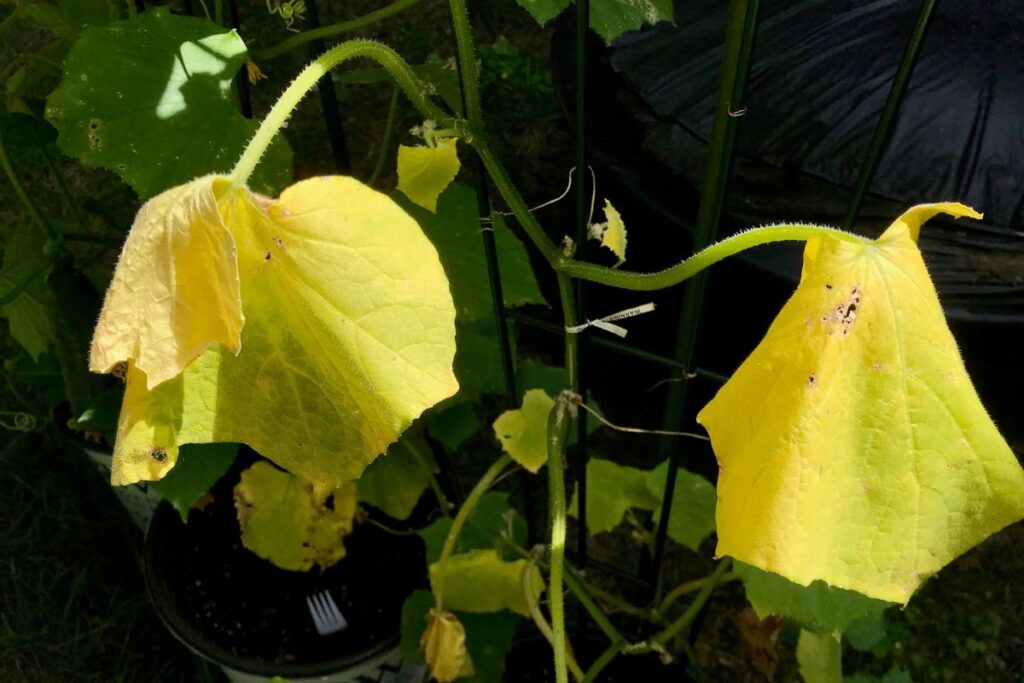
Temperature stress can cause cucumber leaves to turn yellow, but overwatering or underwatering may also be the culprit. If you’ve been watering your cucumber plant too much, its roots could become waterlogged and unable to absorb enough oxygen from the soil. This leads to a lack of nutrients in the leaves and will result in them turning yellow and wilting.
Alternatively, if a cucumber plant is not getting sufficient hydration, it won’t have access to essential minerals and vitamins either – resulting in yellowing of the leaves as well.
How to determine overwatering or underwatering of cucumber plants?
To determine whether your cucumbers are being overwatered or underwatered, take pictures of them and their environment.
- Is there standing water around the base?
- Are the surrounding plants suffering from similar symptoms?
These clues can help guide your decision about how much water your cucumbers need. Another telltale sign that you’re giving your cucumbers too much H2O is if the leaves start developing spots or begin drooping severely.
How to Prevent Overwatering or Underwatering of Cucumber Plants?
The best way to prevent overwatering or underwatering is by understanding what type of soil conditions your specific variety requires. Then sticking to those guidelines when irrigating. Consider investing in moisture meters which allow you to measure precisely how wet or dry the soil is before adding more liquid into the mix.
With proper monitoring and care, you should soon see an improvement in the health of your cucumber plants!
Plant Age
One of the common reasons why cucumber leaves are turning yellow is because of their age. Cucumbers typically only stay green for a few weeks before they start to turn yellow and brown.
As plants age, their leaves will naturally change color due to photosynthesis slowing down or stopping altogether.
Another factor related to aging that can affect leaf coloration is the health of the roots. When roots become weak or damaged, it can stress the entire plant which may lead to the premature yellowing of leaves.
What are Diagnosis Strategies For Cucumber Leaves Turning Yellow?
Having discussed the age of a cucumber plant as a possible cause of yellowing leaves, it is now necessary to explore other strategies for diagnosing why the leaves may be turning yellow. Here are four potential methods that can help determine the problem:
- Observe Plant Environment: Check the surrounding environment where the cucumber plant is located and look for any signs of pests or diseases. Additionally, inspect soil moisture levels and light exposure to ensure they are adequate for healthy growth.
- Inspect Leaves Carefully: Look closely at each leaf on the cucumber plant to identify if there are any spots, discolorations, burns, or wilt present which could signal an insect infestation or fungal infection causing yellowing leaves.
- Analyze Fertilizer Use: Examine fertilizer use patterns to see if too much nitrogen has been applied recently which can lead to yellow foliage in some plants such as cucumbers.
- Test Soil Quality: Taking a sample from around the roots of the cucumber plant and testing its pH level can give insight into whether nutrient deficiencies are occurring due to improper soil acidity/alkalinity balance leading to yellow leaves.
These diagnostic steps offer an opportunity to uncover what might be causing your cucumber’s leaves to turn yellow so that you can take corrective action accordingly. By investigating these areas, you will have greater confidence in addressing this issue with your cucumber plant and hopefully bring back lush green growth soon!
Treatment Options For Cucumber Leaves Turning Yellow
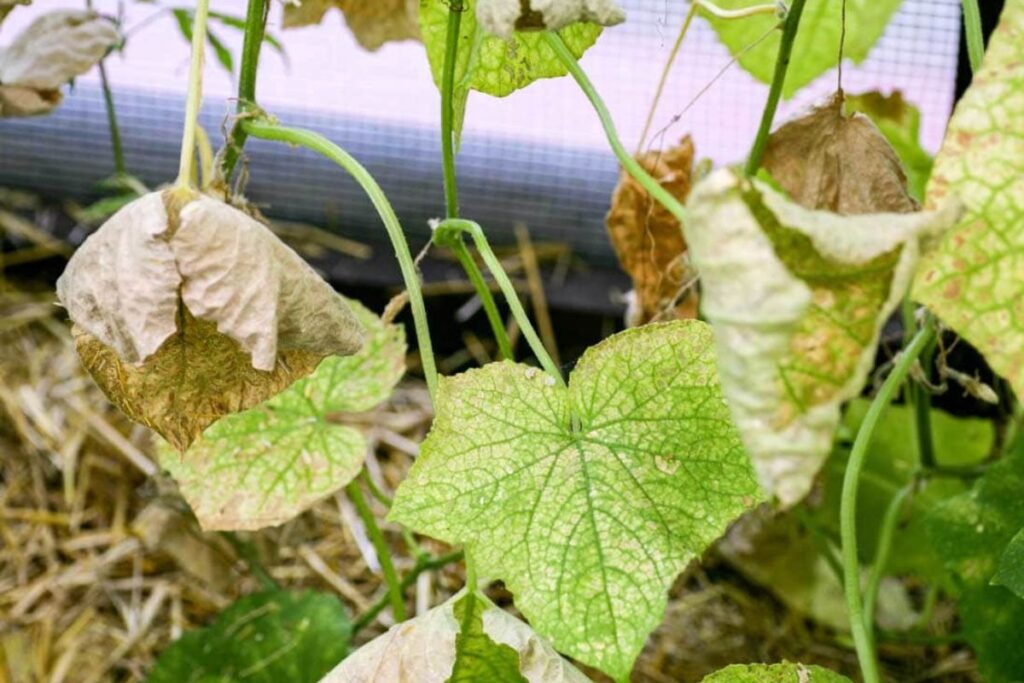
The most important step to take when trying to correct yellow cucumber leaves is to identify the underlying cause. It could be due to a variety of factors, such as nutrient deficiencies, disease, or pest infestations. Once the root of the problem has been identified, it’s time to find an appropriate treatment option.
One way to fix yellow cucumber leaves is by checking for and treating any diseases that may be present in the plant. This includes checking for fungi like powdery mildew and downy mildew which can turn cucumber vines yellow.
If either of these are discovered, fungicides should be used in order to control their spread. Additionally, bacterial leaf spots can also lead to cucumber leaves turning yellow and brown; copper-based sprays can help manage this issue.
Finally, if there appears to be no sign of disease or pests on your cucumbers but you’re still seeing leaves on your cucumber plants turning yellow around the edges, then it likely means there’s a lack of nutrients in the soil. In this case, fertilizers containing nitrogen should be applied every two weeks until new growth begins appearing on the plant again.
By taking all necessary steps and tending carefully to your cucumbers with proper diagnosis and treatments, you should soon have green healthy foliage growing once more!
Related Reading:
The Ultimate Guide To Cucumber Pests and Diseases
How To Prevent Cucumber Leaves Turning Yellow?
The previous section discussed treatment options for when your cucumber leaves are turning yellow, but it is better to prevent the problem before it starts. To avoid this issue from occurring, there are several steps you can take.
Firstly, why are my cucumber leaves dying?
The most common cause of yellowing and wilting of cucumbers on the vine is lack of water or too much heat. Make sure that your plants have access to plenty of water in hot weather and lots of sun exposure in cooler temperatures.
Cucumber leaves may also turn yellow around the edges if they are not getting enough nutrients such as nitrogen or phosphorus. Feed your garden with a balanced fertilizer regularly to ensure that all essential minerals are available for growth.
Additionally, pay attention to any yellow spots on your cucumber leaves and inspect them carefully; these could be an indication of disease or pest infestation. If you notice anything unusual, treat it quickly with a fungicide or pesticide as soon as possible.
Finally, it’s important to remember that many problems related to cucumbers start in the soil: make sure it has good drainage and aeration so roots don’t stay wet for too long. Test its pH level annually and adjust accordingly using lime or sulfur if necessary – what causes yellow spots on cucumber leaves can often be attributed to incorrect soil acidity levels!
Taking these preventive measures will help keep your cucumbers healthy and strong throughout the growing season.
Conclusion
In conclusion, yellow leaves on cucumber plants can be caused by a variety of factors. Nutrient deficiencies and environmental conditions like soil pH or temperature can all contribute to the problem.
Additionally, fungal or bacterial diseases may also play a role in causing yellow leaves. The best way to diagnose the issue is to observe your plant carefully for signs of disease and check the growing environment for any changes that could have led to nutrient deficiencies.


